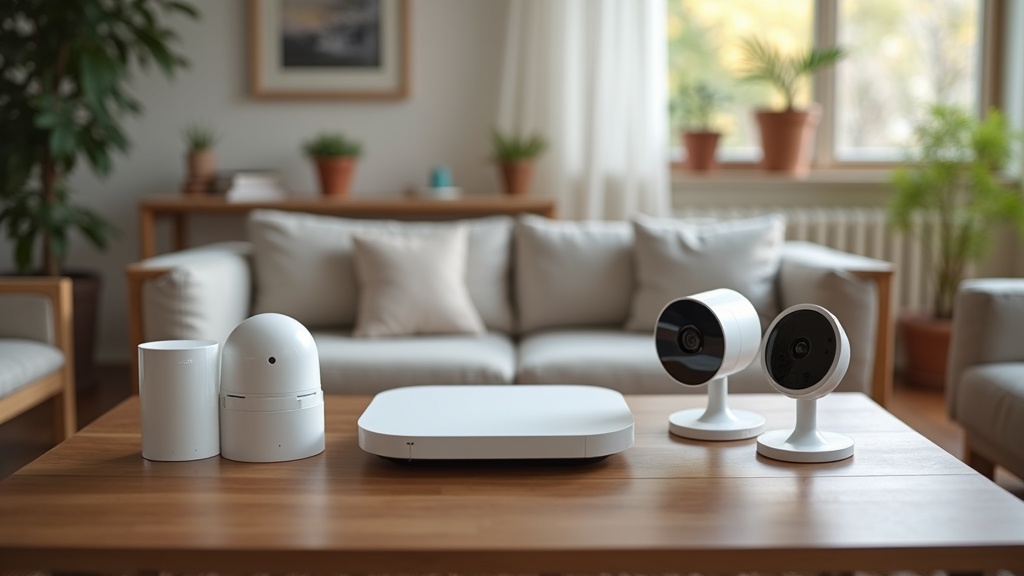Smart home security systems are popping up everywhere lately, and for good reason. They blend classic home protection with tech that actually makes our daily routines smoother. I’m always surprised by how much convenience and peace of mind they add. For anyone curious about what a smart home security system really is or how it stands apart from old-fashioned alarms, I’m here to break it all down, simple and straight from the ground up.

What Exactly Is a Smart Home Security System?
Most people hear “smart security system” and just think of alarms, but there’s a lot more to it. A smart security system is a connected network of security devices (think cameras, motion sensors, smart locks, and more) that all talk to each other and to you using your Wi-Fi. Everything can be monitored or managed from your phone or tablet. This means you can keep tabs on your home, no matter where you are.
When someone mentions “home security system,” they mean a setup of devices, like door sensors and alarms, built to detect intrusions and alert you if something’s up. But a smart home security system takes things further. Now you get real-time notifications, plus automation, remote management, and plenty of ways to make things feel more personal. This setup can scare off would-be thieves, alert you immediately, and can even help you with daily tasks by linking up with things like your lights or thermostat.
Smart Security System: The Basics and Definition
The true meaning of a smart security system comes down to three main points:
- Connected Devices: All the gear—think smart cameras, window sensors, smart doorbells—communicate via your home Wi-Fi or special smart home tech.
- Remote Management and Automation: I love knowing that I’m able to check camera feeds or arm/disarm my system straight from my phone. You can also set up actions to happen automatically, like having lights turn on if motion is detected.
- Easy Customization: No engineering degree required—these setups are easy to use and user friendly, giving you more control without the hassle of complicated configurations.
The main point isn’t just stopping unwanted visitors; it’s about making home protection way more hands-off, customizable, and responsive to fit your lifestyle.
How Does a Smart Home Security System Work?
At its heart, a smart security system includes several key devices. Here’s a basic rundown of what you’ll find in most setups:
- Smart Cameras: They give you live or recorded video, inside or outside your home. You can view what’s happening from anywhere on your smart device.
- Contact Sensors: These sensors on doors and windows alert you if something’s been opened or closed at the wrong time.
- Motion Sensors: If any movement is picked up where it shouldn’t be, you receive a notification right away.
- Smart Locks: Forget hiding keys near the door. You can lock or unlock from your phone or set up unique codes for delivery people or visitors.
- Alarms & Sirens: They make loud noise to let intruders know they’re on camera and push you (and sometimes the authorities) to act fast.
- Smart Hubs: Think of this as the command center, pulling all your tech together for seamless control from one app.
The power really shines through how these pieces work together. If a door sensor trips, your smart camera instantly records and sends you footage; your lights switch on and your alarm sounds, all within seconds.
The Purpose of a Smart Home System
The main mission behind smart home systems is mixing security and convenience. Old systems mostly reacted to threats, sometimes awkwardly. Now, with smart tech, things are more about preventing problems and staying ahead. Smart systems record everything as it happens, allow you to arm or disarm from anywhere, and blend with smart lights or other gadgets to make it look like someone’s always home—even when you’re not around.
This is handy for more than deterring burglars. You can keep watch on kids or pets, get notifications if the smoke alarm goes off, or check when deliveries come in. So, you’re not just securing your home—you’re staying in touch with everything you care about inside it.
Main Features of Smart Home Security Systems
Here are some cool features that make these systems worth tracking down:
- Remote Monitoring: Watch live feeds or check alerts from your phone—even if you’re halfway across the globe.
- Smart Alerts: Get instant notifications for things like motion detection, doors opening, or cameras spotting an unfamiliar face.
- Two-Way Audio: Chat with someone at your front door even when you’re out, all through your smartphone.
- Cloud Storage: Video clips and history are saved online, making it easy to go back to old footage as needed.
- Automation: Program routines or schedules like arming the system automatically every night or turning lights on/off for extra security.
- Integration with Other Smart Devices: Link your security system to smart speakers, video doorbells, thermostats, and other gadgets for easier control and smoother routines.
What is Smart Home Control?
Smart home control is your ticket to running all your connected tech—security included—using a single app or voice assistant. You can match up the locking of doors, camera checks, chats with someone at the front door, or get system status updates all without being at home. Some setups take it a step further through scenes: hit “Goodnight” on your phone, and the system locks everything up, lowers the thermostat, turns out lights, and arms the security, all at once.
Having this kind of control is what makes smart systems truly stand out from older, single-purpose alarms. I can use it every day—not just for safety, but for things like automating lights or checking who’s knocking at the front door.
Before You Set Up a Smart Home Security System
A few things to consider before you get started:
- Wi-Fi Strength: Everything runs on Wi-Fi, so make sure you have solid coverage throughout your house for a reliable setup.
- Compatibility: Double-check if your sensors and cameras will work with your main hub or chosen app, especially if you plan to grow your system over time.
- Privacy: Video and audio data are sensitive, so look at privacy options and find out exactly who can access your footage.
- Budget: Kits start at very affordable prices and go up to professional levels, so it helps to figure out which features you’ll actually use day-to-day.
Spend some time doing a little homework ahead of time—it pays off in the long run with a smoother, stress-free experience.
Pro Tips for Getting the Most Out of Your System
Here are a few practical tips I’ve picked up:
- Install cameras high enough to capture wide views, but low enough for clear images of faces or license plates.
- Set zones in your camera or sensor apps so that you don’t get bombarded with alerts for harmless routine stuff, like passing cars.
- Try out the app interface before settling on a system. The best ones are quick, responsive, and easy to understand.
- Stay up to date with firmware updates, since these often bring new features and better security.
Minor tweaks and regular checkups help your tech run without a hitch and your home stays extra safe.
Frequently Asked Questions
What is the definition of a smart security system?
A smart security system is a set of connected security devices (cameras, sensors, locks, and more) all managed through your home network, so you can control and monitor everything remotely via one app or platform.
What’s the purpose of a smart home system?
The goal of a smart home system is to make homes safer and daily routines smoother by automating and connecting tech gadgets—security devices, lights, and more—for more control, comfort, and peace of mind.
What is the meaning of home security system?
A home security system is any bundle of devices—like alarms, cameras, and sensors—built to spot and stop unauthorized entry or dangers to your house.
What is smart home control?
Smart home control is the ability to run all your smart gadgets (including security) from one place, making it super simple to lock down, monitor, and automate your space—even when you’re miles away.
Wrapping Up
Adding smart tech to home security is a definite step up for anyone who wants a safer, more convenient space to live in. Pick the system that suits you, take time to set it up properly, and stay on top of updates; you’ll reach a whole new level of peace of mind.
Begin with what matches your daily routine and expand at your own pace. Smart home security systems are flexible, simple, and packed with features, making it easy for you to keep a watchful eye on your home.

This was a very interesting and helpful article—thank you for breaking it down in such a clear and relatable way! I’ve been visiting Las Vegas pretty often, and it always amazes me how fast technology is becoming part of everyday life—even in homes. The idea of being able to monitor everything from your phone while you’re across the country (or just down the street) is both fascinating and incredibly practical.
I especially appreciated the section about smart home control—being able to link up lights, locks, and security in one tap sounds like something from the future, but it’s happening right now.
A few questions I had while reading:
1.) Do most smart home systems work well for renters, or are they mainly for homeowners?
2.) How secure is the cloud storage for video footage? Is it encrypted or protected in some way?
3.) What happens if the Wi-Fi goes out—do the alarms or sensors still work?
Thanks again for the insight—definitely makes me want to explore some of these features for my own home!
Thank you very much for reading. You’ve asked some excellent questions. Let me answer them:
1) Many systems do, but some, like Vivint, are not very renter-friendly. They’re geared more toward homeowners.
2) Companies go to great lengths to keep things secure, but smart systems can be exposed to hacking if you don’t use strong passwords or update software. While security companies continue to improve protection against this, a little caution is smart for users too.
3) If your system relies solely on Wi-Fi, you’ll have gaps in service when it goes out. It’s best to also have local storage or cellular backup.
Keep an eye out for my post on the best security systems for renters. It’s coming very soon.
As always, feel free to reach out anytime.
Best wishes,
Jeff
Thanks for your interesting post on Smart Security Systems. If I was to upgrade my current security system ( which is not being used currently) what is the best option I should consider and is it simple to use? Not being a big fan of apps, I would want it user friendly and know if it is something that is compliant in other countries around the world outside the US? What kind of outlay in $$ would it entail?
Regards Helen
Helen, thanks for reading and for asking your question. If you’re not a big fan of apps, you can still use a traditional system, or a blend of both.
Generally, the software works in most countries with adequate Wi-Fi. That’s a good question for you to ask a potential service provider.
The cost depends on many factors, including the size of your dwelling (read: amount of equipment you need) and the type of system you want.
This is where research (ugh) comes in.
Be sure to watch for more posts coming very soon that touch on some of these issues. And you’re always free to ask me more questions.
Best wishes,
Jeff